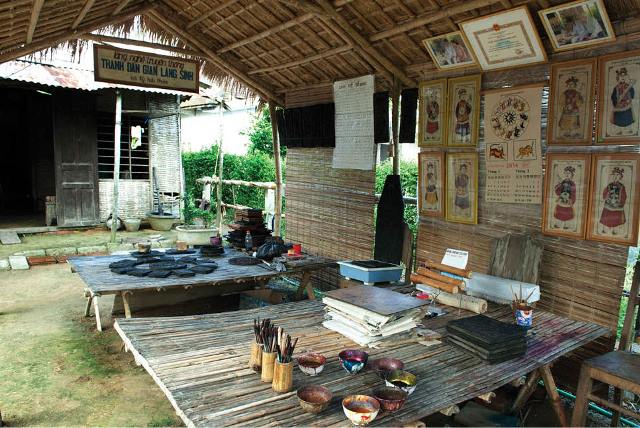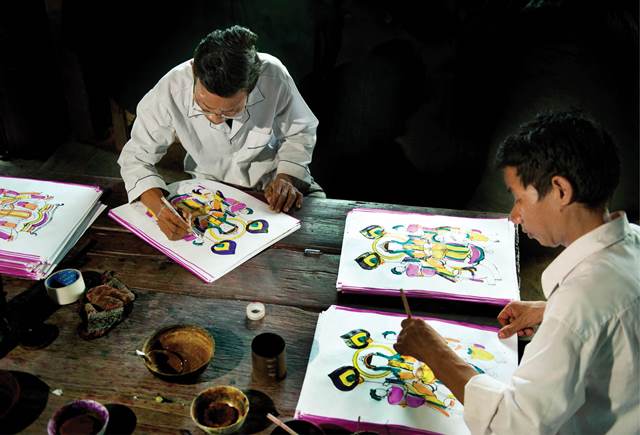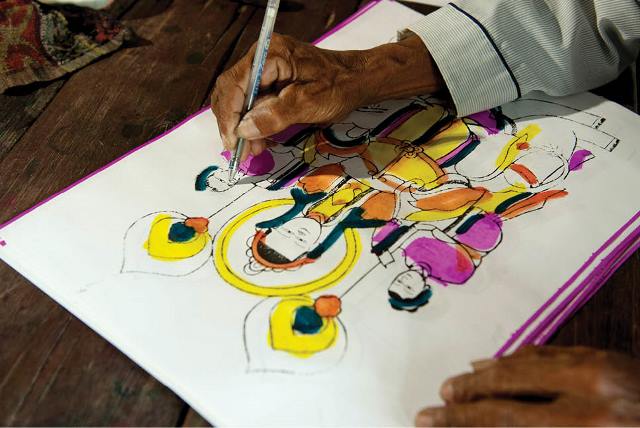
Sinh is the informal name of Lai An village, about 7 kilometers northeast of the Citadel. There is a splendid village hall standing by an old Banyan tree in the middle of the village; and, facing the river, an ancient temple, Sung Hoa, is at one end, and a church at the other end.
Sinh used to be known as a village of rice and flowers. The flowers dye the two river banks yellow in spring. In the village, the paths are shaded by bamboo trees. I admire the beauty of the village, especially when the sun rises drying the dew in spring.
Yet the village is well-known for its folk paintings. Sinh paintings have been qualified by experts as valuable figurative works in the treasure of Vietnamese woodblock paintings. They are as good as paintings of craft villages such as Dong Ho (Bac Ninh) and Hang Trong (Hanoi).

Sinh paintings are printed on poonah-paper. Villagers have to go as far as Quang Binh to buy this kind of paper. After Tet holiday, on the tenth day of lunar year, there is a village wrestling competition to find out the strongest men. These people will go and search the Indian redwood and the Japanese pagoda tree in the forest, and the noble scallop in the sea to dry and pulverize to make colors for painting.
These materials are mixed with sticky rice powder and water, and the mixture is then spread on poonah-paper before a woodblock is used to print a picture on the paper. Sinh painting can be said to be a harmony of the forest, the sea and the rice field. Each painting bears the homeland essence.
I remember reading somewhere that Hue is a vivid cultural center where Buddhism and Confucianism have been part of the local life, nourishing religious ideology, philosophy and morality in a unique way.

Sinh painting is evidence of that uniqueness. Hue people take the ancestor worship seriously, and thus paying attention to finesse in shape, simplicity and warmth in colors, and scent of paper. The beliefs manifest the cultural depth and elegance of the ancient capital.
When I asked my friend whether Sinh villagers preserved their traditional craft of painting, she told me “Have a comeback to see your dream come true.” I wonder what I wished. Thirty years ago, when the village traditional craft was at risk of loss, I wished that I would see the village girls chuckling while drying the paintings in the spring sun. I also wished that the western visitors would join the children to woodblock print the paintings and bring them around the world. I would like Sinh paintings to become exported handicrafts.

Preserving Sinh paintings
When I was doing my graduation research in Ethnography-Archeology at the Department of History, University of Sciences, Hue University, I rode my bicycle to and from Sinh and neighboring villages for months to collect data from old documents and local people narratives. I was excited to hear the aged people to sing folk songs while milling scallop shells. How graceful they were. They were living folk treasures of unique values waiting for explorations.
I have not been back to Sinh since the completion of my 150-handwriting-pages thesis “Sinh paintings”. When I asked my friend if there was anyone making Sinh paintings in the old style, that is, the kind of fragrant poetic paintings, he nostalgically said: “It was just a memory, I’m afraid. Sinh paintings are now more colorful with coloring products and are printed on better paper.”
I know it is important to be adaptive to preserve the village’s paintings. As long as the woodblock is still in use, the spirit of Sinh paintings still exists. Yet, I still have a feeling of loss.
Hue in my thought is like a Sinh painting. The current adaptation makes Hue modern and dynamic, but there is still a quiet Hue with hidden cultural values to be uncovered at the right time.
My friend – a humble Hue woman – wishes Hue to become rich, but it was the richness in nature, culture and spirit rather than material wealth. It is true that Hue has been naturally and culturally rich in a way that makes others admire.
Hue is like a big garden full of flower colors and bird songs. This is hardly found in other cities in our country. My friend told me that her mother asked her and siblings to preserve the traditional architectural style if they have their house built, especially a covered front gate that could offer passers-by a place to shelter when it suddenly rained. Her mother also asked them not to throw away leftovers, but put them in a place visible to birds. Hue is nature-friendly and thus, it often brings a cozy feeling that urges visitors to have a return visit.
Hue will be bigger according to urban planning. “The green heritage” that Hue leaves the next generations is certainly a convergence of forests, seas, rice fields and rivers, with vivid colors and well-being.
I know I cannot go back in time, but I love the homely fragrance in the old painting and I still wish that Sinh paintings would be globally known.
Story: Tran Hong Hieu
Photos: Truong Vung